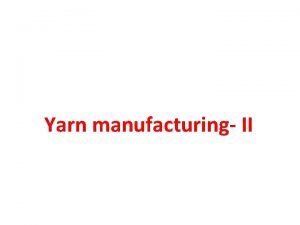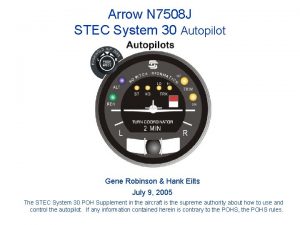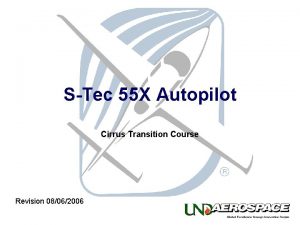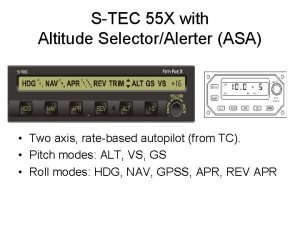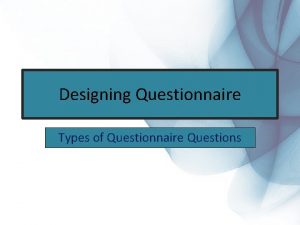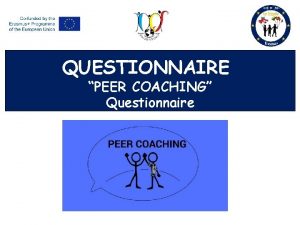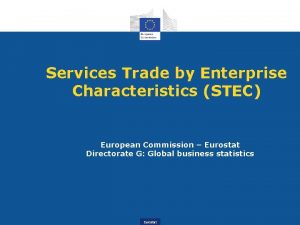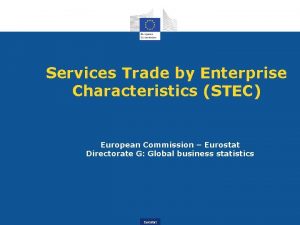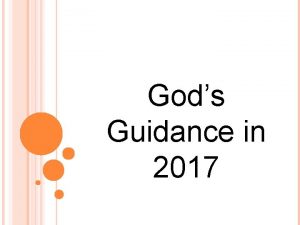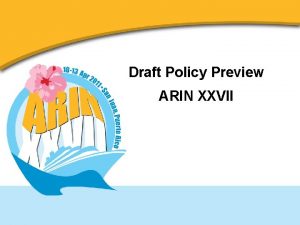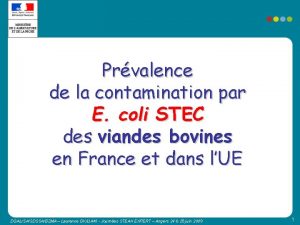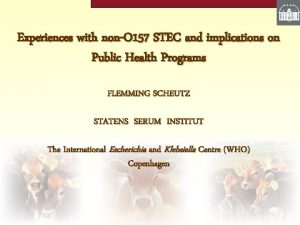STEC questionnaire Questionnaire on the Commission draft guidance



















- Slides: 19

STEC questionnaire Questionnaire on the Commission draft guidance document on the application of Article 14 of Regulation N° 178/2002 as regards food contaminated with STEC 1

STEC guidelines Number of questionnaires received 7 2 21 questionnaires EU-MS no questionnaire (EU-MS) questionnaires non-EU States CH, NO BG, EL, ES, HU, MT, PT, RO 2

Question 1 Taking into account the 2013 EFSA scientific opinion on "VTECseropathotype and scientific criteria regarding pathogenicity assessment" , should DG SANTE continue to consider the seropathotype approach (Karmali et al. , 2003) as suitable to categorise VTEC strains according to their potential to cause serious human diseases? SK IT, LV, PL, SI, NO, CH n/a 1 YES 6 NO 16 3

Question 2 Hazard characterisation: which combination of STEC analytical results would lead you to consider a STEC hazard entailing a high risk of causing a serious human disease if directly ingested by consumers? BE EE HR CY LU PL SK NO CH SE* Isol. + stx + eae or [aai. C+agg. R] DK DE IE IT NL AT SI UK* Isolation + stx CZ FR FI other LT only PCR stx & eae or [aai. C+agg. R] only PCR stx *originally replied “other” LV: n/a 0 2 4 6 8 10 4 12

Question 3 Do you think that the scope of the STEC guidance should be limited to retail level only rather than considering all stages of the food chain (e. g. also carcass level)? YES, Retail only 6 NO, all stages FC 17 5

Question 3. 1 If YES (retail only), which of the following approaches would be acceptable for your country to assess the exposure of consumers to STEC hazard at retail level? food profiles flowchart 2, but deleting food category "d" 2 AT, CH RTE and non-RTE food 4 FR, LU, PL, SK 6

Question 3. 2 If NO (all stages FC), which of the following approaches would be acceptable for your country to assess the exposure of consumers to STEC hazard at retail level? DK, DE, IE, FI, SE, UK, NO food profiles flowchart 2 7 10 other BE, CZ, EE, HR, IT, CY, LV, LT, NL, SI 7

Question 4 Risk management recommendations: taking into account the exposure assessment and the hazard characterisation, which of the following approaches should be recommended? FP 1: isol. + stx & eae or [aai. C +agg. R]; FP 2: "top serogroups" Other FP 1: isolation + stx; FP 2: "top serogroups" EE HR CY LT LU PL SK NO CH 9 DK IE FR NL FI SE UK 7 BE CZ IT SI 4 DE AT Only FP 1 2 FP 1: only PCR stx; FP 2: "top serogroups" 0 FP 1: only PCR+ stx+eae or [aai. C +agg. R]; FP 2: "top serogroups" 0 LV: n/a 8

Food profile 1 Question 4 Risk management recommendations: taking into account the exposure assessment and the hazard characterisation, which of the following approaches should be recommended? EE HR CY LT LU PL SK NO CH DK FP 1: isolation + stx + eae or [aai. C +agg. R] BE CZ IT SI DE AT IE NL SE UK FP 1: isolation + stx FR FI Other 0 2 4 6 8 10 9 12

Food profile 2 Question 4 Risk management recommendations: taking into account the exposure assessment and the hazard characterisation, which of the following approaches should be recommended? EE HR CY LT LU BE CZ IE IT SI PL SK NO CH NL FP 2: isol. + stx + eae or [aai. C +agg. R] + "top" serogroups FP 2: no actions recommended DE AT FP 2: isol. +stx+other markers SE UK FP 2: isolation + stx FI FR DK other 0 2 4 6 8 10 12 14 10 16

STEC surveillance Question 5 As Competent authorities, are you carrying out any national monitoring programmes on VTEC? Question 5. 1 If YES, has your national monitoring programme on VTEC changed after the publication of the EFSA scientific opinion on STEC in 2013? NO 6 BE, CZ, NL YES 3 YES 17 BE, CZ, DK, DE, EE, IE, FR, IT, LV, LT, LU, NL, AT, PL, SI, FI, NO NO 14 11

STEC surveillance Question 5. 3 -5. 4 DE, AT, CH BE, PL, UK 5. 3 Should the Commission consider laying down surveillance criteria/ recommendations in future? no opinion 3 NO 3 YES 17 5. 4 If YES, what kind of surveillance criteria/recommendations would be appropriate and for whom (CAs , FBOs, both)? Both 13 (+1) CZ EE FR HR IT CY LV LT LU NL SI SK NO (+PL) FBO 2 DK FI CA 1 SE n/a 1 IE 12

Question 6 Micro-criteria NO 1 Should the Commission consider proposing a general food safety criterion for STEC? (PL) (SE) No opinion 1 YES 21 Question 6. 1 If yes, for which kind of food commodities (e. g. RTE food only, all types of food, please specify)? RTE 12 BE CZ DK DE EE IE FR IT AT FI NO CH All food 7 HR CY LV LT PL SI SK FP 1 2 LU NL 13

Question 6. 2 Micro-criteria If yes, should DG SANCO continue meanwhile working on the guidance document? FR LU AT SK NO 4 YES 17 14

Question 7 Micro-criteria Should the Commission consider strengthening the current specific food safety criterion for sprouts considering the 2013 EFSA opinion? no opinion (AT) CZ, DE, EE, FR, HR, LT, LU, PL, FI, SE NO 10 YES 12 BE, DK, IE, IT, CY, LV, NL, SI, SK, UK, NO, CH 15

Analytical methods Question 8 Q 8 - As CA, which of the following methods do you use to detect STEC when performing official controls? Other 5 DE IE LU SK FI BE EE FR IT AT PL SI SK FI SE ISO 13136 (no EAEC) 10 ISO 13136 adapted 16 CZ DK EE IE HR IT CY LV LT NL SK FI SE UK NO CH 16

Analytical methods Question 9 Q 9 - Which analytical methods are usually used by FBOs to detect STEC? ISO 13136 to detect only 'traditional STEC' 7 BE DK DE EE LV NL NO ISO 13136 EURL 4 CZ EE CY? IT? PCR only (RT-PCR, PCR 4 multiplex) CZ IT UK CH ISO 16654 3 FR PL FI Immunological tests, IMS, ELISA (serogroups: O 157, O 103, O 26) 4 IE FR NO CH n/a 6 HR LT LU SI SK SE 17

Question 10. 1 Did you change your policy/approach to manage food contaminated with STEC after the publication of the EFSA scientific opinion on VTEC in 2013? BE, EE, IE, NL, UK YES 5 NO 18 18

Thank you very much for your attention 19
 Objects of draw frame
Objects of draw frame Example of significance of the study
Example of significance of the study Stec 30 autopilot
Stec 30 autopilot Stec 55 autopilot
Stec 55 autopilot Stec 55
Stec 55 Incisal guidance angle value
Incisal guidance angle value Indirect skills
Indirect skills Graduated commision
Graduated commision Defects of present curriculum
Defects of present curriculum ưu thế lai là gì
ưu thế lai là gì Tư thế ngồi viết
Tư thế ngồi viết Thẻ vin
Thẻ vin Thể thơ truyền thống
Thể thơ truyền thống Các châu lục và đại dương trên thế giới
Các châu lục và đại dương trên thế giới Từ ngữ thể hiện lòng nhân hậu
Từ ngữ thể hiện lòng nhân hậu Diễn thế sinh thái là
Diễn thế sinh thái là Thế nào là giọng cùng tên?
Thế nào là giọng cùng tên? Vẽ hình chiếu vuông góc của vật thể sau
Vẽ hình chiếu vuông góc của vật thể sau 101012 bằng
101012 bằng Hát lên người ơi alleluia
Hát lên người ơi alleluia
